Life Science Analytics Market Size
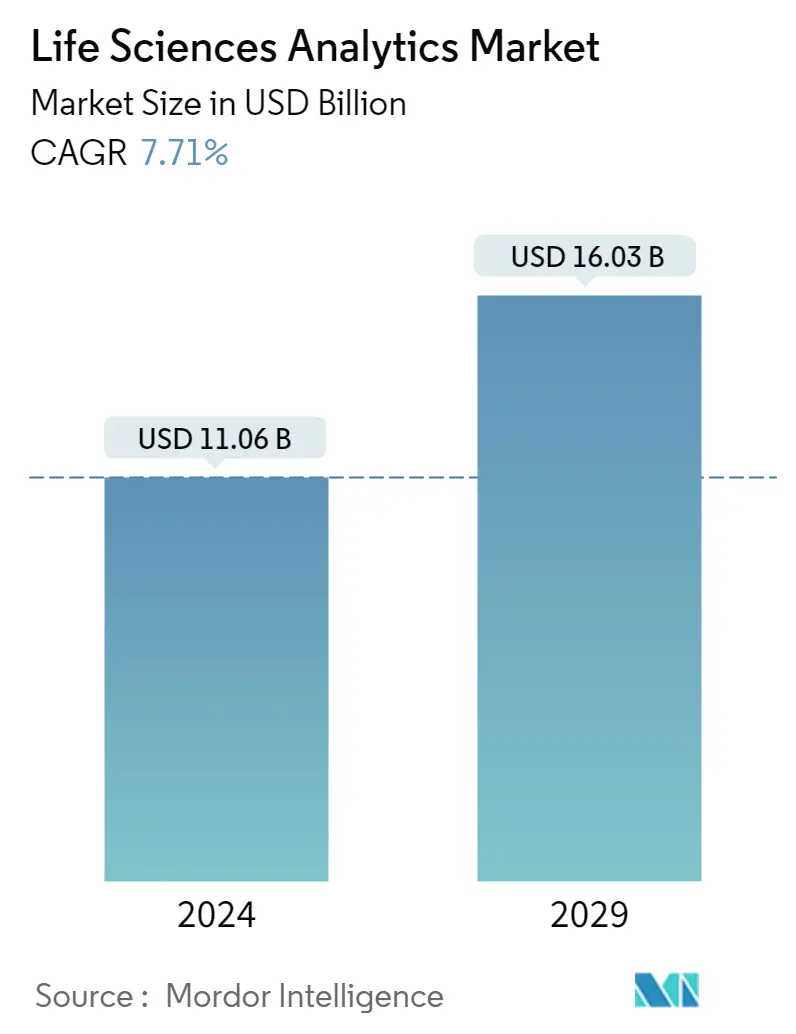
| Study Period | 2021 - 2029 |
| Market Size (2024) | USD 11.06 Billion |
| Market Size (2029) | USD 16.03 Billion |
| CAGR (2024 - 2029) | 7.71 % |
| Fastest Growing Market | Asia Pacific |
| Largest Market | North America |
Major Players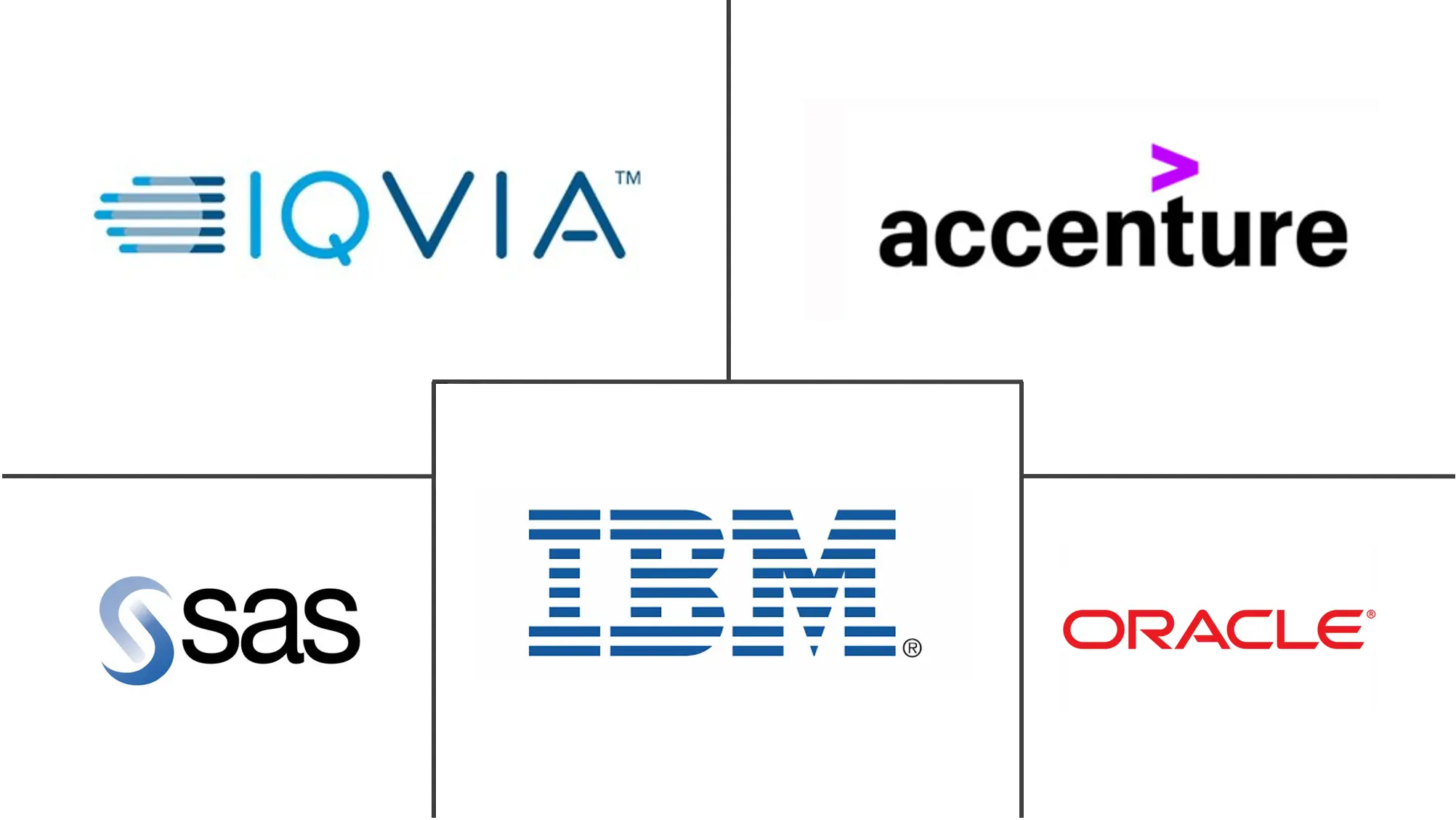
*Disclaimer: Major Players sorted in no particular order |
Life Science Analytics Market Analysis
The Life Sciences Analytics Market size is estimated at USD 11.06 billion in 2024, and is expected to reach USD 16.03 billion by 2029, growing at a CAGR of 7.71% during the forecast period (2024-2029).
The outbreak of COVID-19 contributed to the rise in demand for analytics, as several clinical trials were conducted for the vaccines for COVID-19. In March 2020, the US Department of Veterans Affairs (VA), Department of Energy (DOE), Department of Health and Human Services (HHS), and National Security Council (NSC) formed the COVID-19 Insights Partnership. The COVID-19 Insights Partnership is leveraging big data analytics tools to research and find possible treatments for the virus. For instance, in November 2021, a predictive analytics model was developed based on an artificial neural network (ANN) model to predict the future number of daily cases and deaths caused by COVID-19 in a generalized way. It showed approximately 86% overall accuracy in predicting the mortality rate and 87% in predicting the number of cases. Thus, life sciences analytics models have proven to be effective in the wake of the COVID-19 pandemic, contributing to market growth. Hence, the COVID-19 pandemic has had a significant positive impact on the market studied. Additionally, due to the significance of analytics, the demand for life science analytics is expected to grow considerably in the future.
The significant factors for the growth of the life sciences analytics market include the rising adoption of analytics solutions in pharmaceuticals and clinical trials, growing pressure to reduce healthcare spending, the need for improved patient outcomes, and the emergence of advanced analytics methods in life science companies.
There is a rise in the use of analytics in clinical trials, as conducting clinical trials has become complex because it involves various activities and generates high volumes of data from different systems. With the changing regulatory protocol requirements for clinical trial conduction and the challenges in data collection, analysis, and preparation of a report quickly for submission to the health authority, the adoption of analytics for clinical trials is on the rise. For instance, in June 2021, IQVIA launched a SaaS-based clinical data analytics platform, Clinical Data Analytics Suite (CDAS), for rapid and intelligent clinical trials.
The emergence of advanced analytics in life science companies is also one of the major factors driving market growth. The 2021 ISG Provider Lens Life Sciences Digital Services Report revealed that life sciences companies in the European region are interested in using analytics to support marketing and sales efforts and optimize supply chain operations. Several other companies are also developing analytics solutions, boosting the adoption and use of analytics solutions. For instance, in September 2021, ZS launched ZAIDYN, a platform for life sciences companies of all sizes to digitally transform and scale customer engagement, field performance, analytics, and clinical capabilities. The emergence of such solutions and products encourages life science companies to develop more advanced analytics solutions, thereby boosting market growth.
In June 2021, JADBio entered into a distribution agreement with QIAGEN to sell and distribute the JADBio offering within the QIAGEN Digital Insights portfolio. JADBio is an AutoML platform with leading-edge AI tools and automation capabilities. It is built to enable life-science professionals to build and deploy accurate and interpretable predictive models quickly and timely, regardless of their data science expertise. Thus, the participation of life sciences companies in developing advanced analytics contributes to market growth.
Thus, factors such as new launches by companies, strategic partnerships, and increasing focus on the implementation of analytics in life sciences are expected to boost the market's growth significantly over the forecast period.
However, a lack of skilled personnel and high implementation costs are expected to restrain the market growth during the forecast period.
Life Science Analytics Market Trends
This section covers the major market trends shaping the Life Sciences Analytics Market according to our research experts:
Pharmaceutical and Biotechnology Companies are Expected to Witness the Rapid Growth in Coming Years
Analytics in clinical research helps pharmaceutical companies analyze data for the comparison of ongoing trials at different sites and populations, prepare reports for submission to the regulatory authority, and get approvals.
The roles of the pharmaceutical companies are to invest in the research and development of new compounds, commit to bringing new drugs to the market to enhance patients' health and quality of life, maintain strict governance when conducting clinical trials, and conduct product development activities for patients and healthcare professionals, following ethical and legal principles.
In October 2021, Ever Fortune.AI and Medexprim announced their strategic partnership dedicated to improving healthcare analytics and medical AI development. This collaboration will expand both companies' networks of hospitals, further connect healthcare innovations between Asia and Europe, bring value to Taiwanese and European hospitals, and strengthen their research ecosystem, bringing a broader mix of General Data Protection Regulation across Europe. It will also allow meeting pharmaceutical companies' needs for patient insights for clinical trials, particularly in oncology and cardiology.
Moreover, in the current scenario, where there is high competition from other major companies, analytics benefits the pharmaceutical and biotech industry. For instance, analytics has helped accelerate drug discovery, optimize clinical trials, and effectively target a specific patient population. For example, in March 2022, the leading research-driven biopharmaceutical company Boehringer Ingelheim and precision medicine software company Lifebit Biotech Ltd entered into a partnership in which Lifebit will support Boehringer Ingelheim in building a scalable data, analytics, and infrastructure platform within its IT environment.
In addition, analytics plays a vital role in getting insights into patient behavior to improve drug delivery and the effectiveness of healthcare. Hence all these factors mentioned above are contributing to the segment's growth.
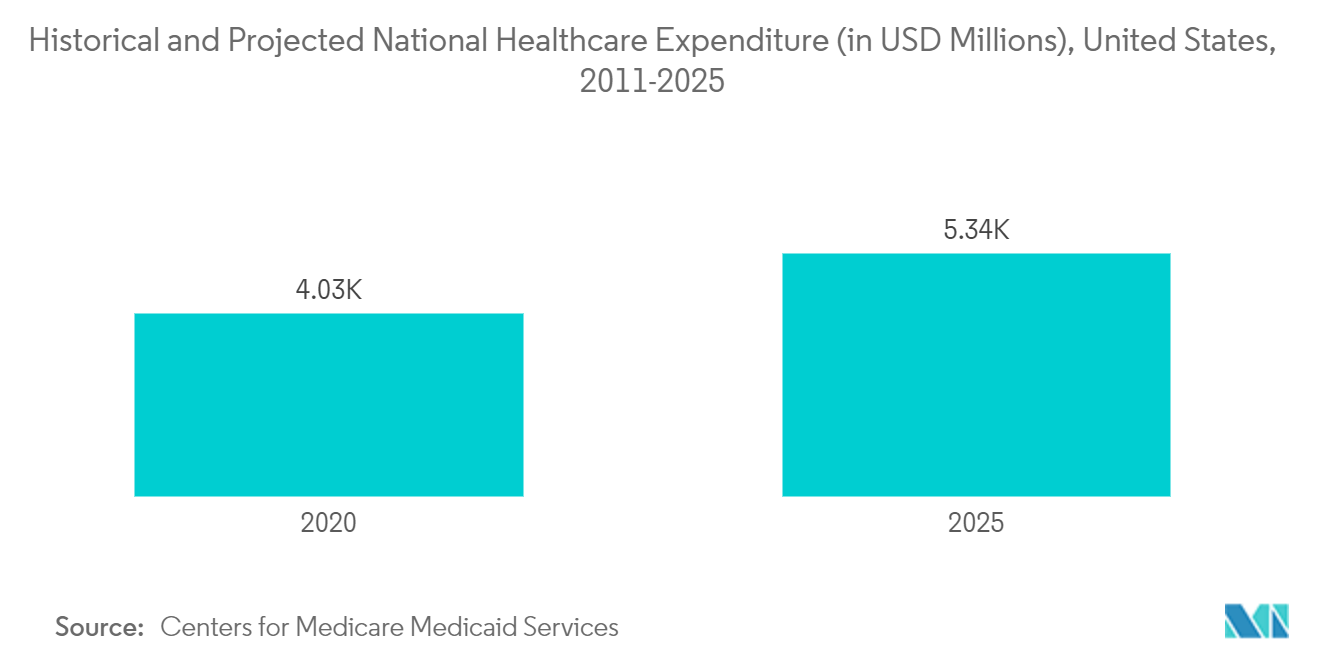
North America is Expected to Dominate the Life Sciences Analytics Market
North America holds a significant share of the life science analytics market as the region is well-established in terms of healthcare R&D. In addition, a considerable rise in healthcare spending by the government and the increasing importance of life science analytics in drug development are other factors fueling the market growth in the region.
Analytics is required to track those trials and manage the companies' data, which helps understand the components needed for new drug discovery or drug development. For instance, in March 2022, the SDG Group entered into a partnership with Snowflake, as the company launched the Healthcare and Life Sciences Data Cloud to bring better patient care and business results. It will enable the SDG group to successfully and securely unlock the power of data and analytics to maximize business value.
The life sciences and pharmaceutical industries face R&D and regulatory changes challenges. The introduction of the Affordable Care Act (ACA) in the United States is changing the regulatory framework, increasing scrutiny and reimbursing based on health outcomes. To tackle these challenges, most companies in the United States are implementing analytics independently or using third-party analytics services for support.
Analytics solutions create an impact that provides simple reporting solutions to descriptive and predictive analytic solutions. The companies based in the United States are adopting new analytics solutions in their business, which include the analysis of clinical research data from the SAS database, helpful in early-stage drug development, analyzing adverse event incidence and reporting in clinical trials, and revenue forecasting and prediction of health outcomes. For instance, in September 2021, Honeywell acquired Performix Inc., a manufacturing execution system (MES) software provider for the pharmaceutical and biotech industries. The acquisition was focused on developing an integrated software platform for customers in the life sciences industry, striving to achieve faster compliance, improved reliability, and better production throughput at the highest levels of quality.
Canada is also witnessing significant growth in the market studied owing to the increasing focus of the Canadian government on the development of the life sciences industry. For instance, data published by the Canadian Government in August 2022 stated that the government took decisive action to ensure access to critical vaccines, therapeutics, and other life-saving medicines by developing a comprehensive strategy to re-build a strong and resilient domestic biomanufacturing and life sciences sector. This initiative by the Canadian government is expected to fuel the life sciences analytics industry in the coming years.
With the life sciences and pharmaceutical companies leveraging support from third-party solution providers in clinical development, trial planning, cohort building, market analytics, and patient analytics, the US market for life science analytics is expected to witness high growth over the forecast period.
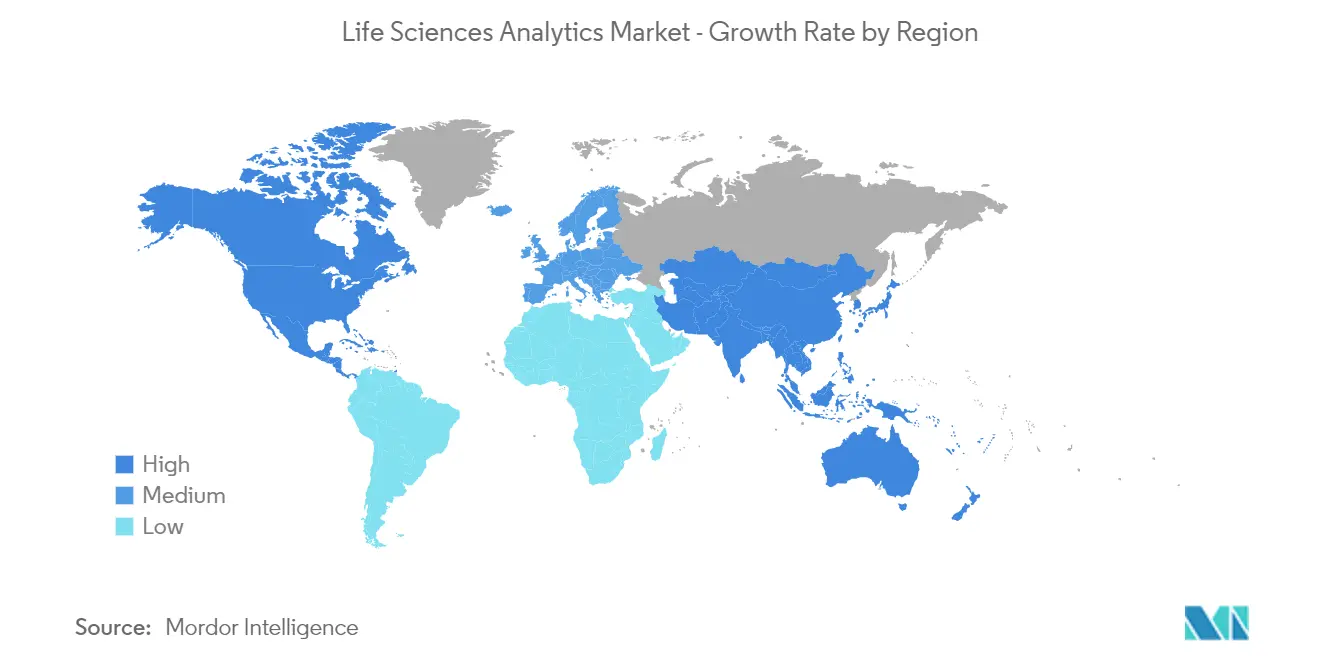
Life Science Analytics Industry Overview
The market studied is moderately competitive, owing to the presence of various players. Some market players are Accenture, Cognizant, IBM Corporation, MaxisIT Inc., Oracle Corporation, IQVIA, SAS Institute Inc., SCIOInspire Corp., TAKE Solutions Limited, and Wipro Limited. Market players readily adopt critical strategies such as partnerships and acquisitions to strengthen their market portfolio.
Life Science Analytics Market Leaders
-
Accenture
-
IBM Corporation
-
Oracle Corporation
-
IQVIA
-
SAS Institute Inc.
*Disclaimer: Major Players sorted in no particular order
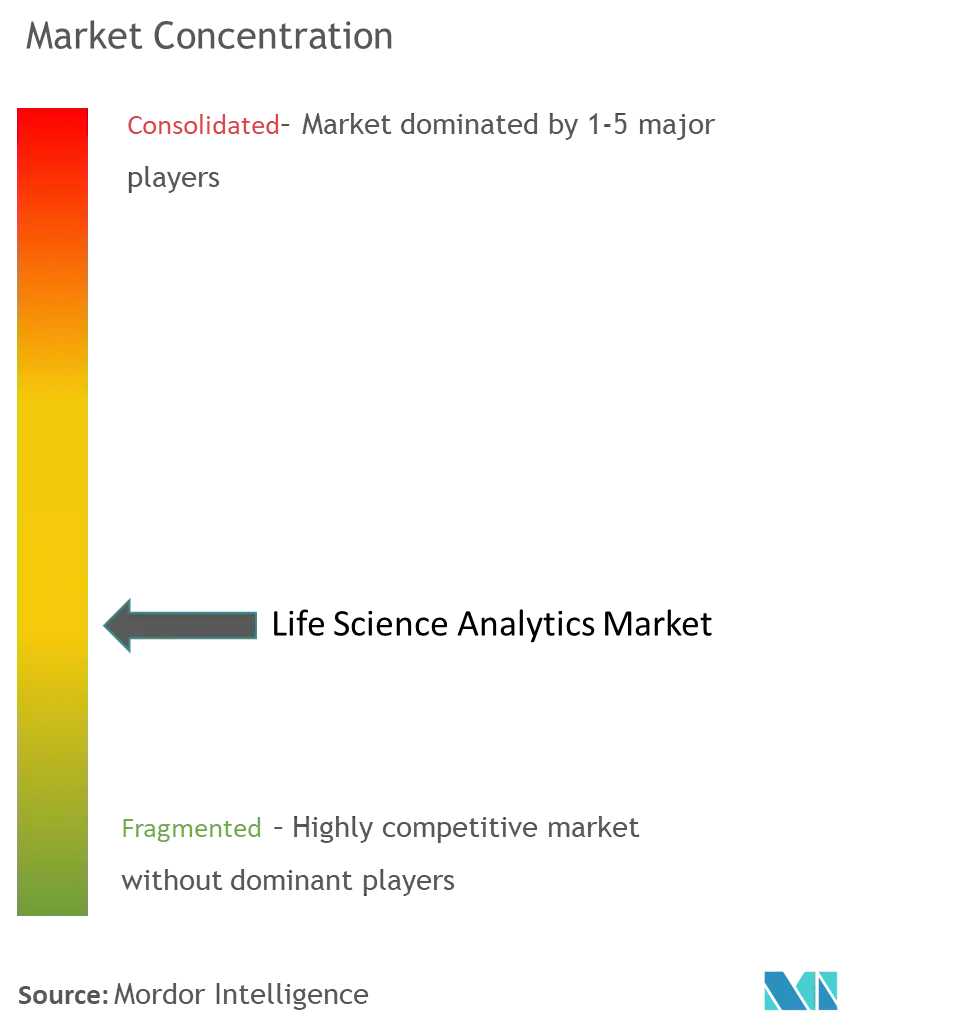
Life Science Analytics Market News
- July 2022: Charles River Associates launched the company's new data analytics suite, the Healthcare Claims Analytics Platform (HCAP), at the World Orphan Drug Congress USA 2022 in Boston. HCAP delivers the power of machine learning and patient analytics to inform about market understanding and support intelligent decision-making.
- March 2022: Databricks launched the Databricks Lakehouse for Healthcare and Life Sciences. It is a single platform for data management, analytics, and advanced AI use cases like disease prediction, medical image classification, and biomarker discovery.
Life Science Analytics Market Report - Table of Contents
1. INTRODUCTION
- 1.1 Study Assumptions and Market Definition
- 1.2 Scope of the Study
2. RESEARCH METHODOLOGY
3. EXECUTIVE SUMMARY
4. MARKET DYNAMICS
- 4.1 Market Overview
-
4.2 Market Drivers
- 4.2.1 Rising Adoption of Analytics Solutions in Pharmaceuticals and Clinical Trials
- 4.2.2 Growing Pressure to Reduce Healthcare Spending and the Need for Improved Patient Outcomes
- 4.2.3 Emergence of Advanced Analytics Method in Life Science Companies
-
4.3 Market Restraints
- 4.3.1 Lack of Skilled Personnel
- 4.3.2 High Implementation Costs
-
4.4 Porter's Five Forces Analysis
- 4.4.1 Threat of New Entrants
- 4.4.2 Bargaining Power of Buyers/Consumers
- 4.4.3 Bargaining Power of Suppliers
- 4.4.4 Threat of Substitute Products
- 4.4.5 Intensity of Competitive Rivalry
5. MARKET SEGMENTATION (Market Size by Value - in USD million)
-
5.1 By Product Type
- 5.1.1 Descriptive Analytics
- 5.1.2 Predictive Analytics
- 5.1.3 Prescriptive Analytics
-
5.2 By Application
- 5.2.1 Research and Development
- 5.2.2 Supply Chain Analytics
- 5.2.3 Sales and Marketing
- 5.2.4 Other Applications
-
5.3 By Component
- 5.3.1 Services
- 5.3.2 Software
-
5.4 By End User
- 5.4.1 Clinical Research Institutions
- 5.4.2 Pharmaceutical and Biotechnology Companies
- 5.4.3 Medical Device Companies
- 5.4.4 Other End Users
-
5.5 Geography
- 5.5.1 North America
- 5.5.1.1 United States
- 5.5.1.2 Canada
- 5.5.1.3 Mexico
- 5.5.2 Europe
- 5.5.2.1 Germany
- 5.5.2.2 United Kingdom
- 5.5.2.3 France
- 5.5.2.4 Italy
- 5.5.2.5 Spain
- 5.5.2.6 Rest of Europe
- 5.5.3 Asia-Pacific
- 5.5.3.1 China
- 5.5.3.2 Japan
- 5.5.3.3 India
- 5.5.3.4 Australia
- 5.5.3.5 South Korea
- 5.5.3.6 Rest of Asia-Pacific
- 5.5.4 Middle East and Africa
- 5.5.4.1 GCC
- 5.5.4.2 South Africa
- 5.5.4.3 Rest of Middle East and Africa
- 5.5.5 South America
- 5.5.5.1 Brazil
- 5.5.5.2 Argentina
- 5.5.5.3 Rest of South America
6. COMPETITIVE LANDSCAPE
-
6.1 Company Profiles
- 6.1.1 Accenture
- 6.1.2 Cognizant
- 6.1.3 IBM Corporation
- 6.1.4 MaxisIT Inc.
- 6.1.5 Oracle Corporation
- 6.1.6 IQVIA
- 6.1.7 SAS Institute Inc.
- 6.1.8 SCIOInspire Corp.
- 6.1.9 TAKE Solutions Limited
- 6.1.10 Wipro Limited
- 6.1.11 Dynata
- 6.1.12 M3 (EU) Ltd
- *List Not Exhaustive
7. MARKET OPPORTUNITIES AND FUTURE TRENDS
** Subject To AvailablityLife Science Analytics Industry Segmentation
Life sciences analytics refers to any analytical application used in clinical research organizations, pharmaceutical, medical device companies, and various divisions, such as research, supply chain, marketing, pharmacovigilance, and others.
The life sciences analytics market is segmented by product type (descriptive analytics, predictive analytics, and prescriptive analytics), application (research and development, supply chain analytics, sales and marketing, and other applications), component (services and software), end user (clinical research institutions, pharmaceutical and biotechnology companies, medical device companies, and other end users) and geography (North America, Europe, Asia-Pacific, Middle East and Africa, and South America). The market report also covers the estimated market sizes and trends for 17 countries across major regions globally. The report offers the value (USD million) for the above segments.
| By Product Type | Descriptive Analytics | |
| Predictive Analytics | ||
| Prescriptive Analytics | ||
| By Application | Research and Development | |
| Supply Chain Analytics | ||
| Sales and Marketing | ||
| Other Applications | ||
| By Component | Services | |
| Software | ||
| By End User | Clinical Research Institutions | |
| Pharmaceutical and Biotechnology Companies | ||
| Medical Device Companies | ||
| Other End Users | ||
| Geography | North America | United States |
| Canada | ||
| Mexico | ||
| Geography | Europe | Germany |
| United Kingdom | ||
| France | ||
| Italy | ||
| Spain | ||
| Rest of Europe | ||
| Geography | Asia-Pacific | China |
| Japan | ||
| India | ||
| Australia | ||
| South Korea | ||
| Rest of Asia-Pacific | ||
| Geography | Middle East and Africa | GCC |
| South Africa | ||
| Rest of Middle East and Africa | ||
| Geography | South America | Brazil |
| Argentina | ||
| Rest of South America |
Life Science Analytics Market Research FAQs
How big is the Life Sciences Analytics Market?
The Life Sciences Analytics Market size is expected to reach USD 11.06 billion in 2024 and grow at a CAGR of 7.71% to reach USD 16.03 billion by 2029.
What is the current Life Sciences Analytics Market size?
In 2024, the Life Sciences Analytics Market size is expected to reach USD 11.06 billion.
Who are the key players in Life Sciences Analytics Market?
Accenture, IBM Corporation, Oracle Corporation, IQVIA and SAS Institute Inc. are the major companies operating in the Life Sciences Analytics Market.
Which is the fastest growing region in Life Sciences Analytics Market?
Asia Pacific is estimated to grow at the highest CAGR over the forecast period (2024-2029).
Which region has the biggest share in Life Sciences Analytics Market?
In 2024, the North America accounts for the largest market share in Life Sciences Analytics Market.
What years does this Life Sciences Analytics Market cover, and what was the market size in 2023?
In 2023, the Life Sciences Analytics Market size was estimated at USD 10.27 billion. The report covers the Life Sciences Analytics Market historical market size for years: 2021, 2022 and 2023. The report also forecasts the Life Sciences Analytics Market size for years: 2024, 2025, 2026, 2027, 2028 and 2029.
Life Science Analytics Industry Report
The Market Report Covers Global Life Science Analytics Companies and is segmented by product type, application, component, end user, and geography. The report offers the value for the above segments. The life science analytics market is seeing significant market growth, driven by advancements in descriptive analytics, predictive analytics, and prescriptive analytics. The market overview indicates a strong market forecast, with industry trends pointing towards increased adoption in research and development, supply chain analytics, and sales and marketing.
In terms of market segmentation, the report highlights the roles of clinical research institutions, pharmaceutical and biotechnology companies, and medical device companies as key end users. The industry analysis within the report provides a comprehensive market review, offering insights into market value and market data. The market outlook is positive, with industry reports suggesting a robust industry outlook and market predictions indicating sustained growth.
The report also includes a detailed industry overview, covering various aspects such as industry size, industry statistics, and industry research. The market leaders in the life science analytics space are identified, providing a clear picture of the competitive landscape. The report pdf is available as a sample for those interested in a deeper dive into the market analysis.
Overall, the life science analytics market is poised for continued growth, supported by strong industry sales and industry trends. The market forecast and market review provide a solid foundation for understanding the future direction of the market. The report example serves as a valuable resource for research companies looking to stay ahead in this dynamic field.



